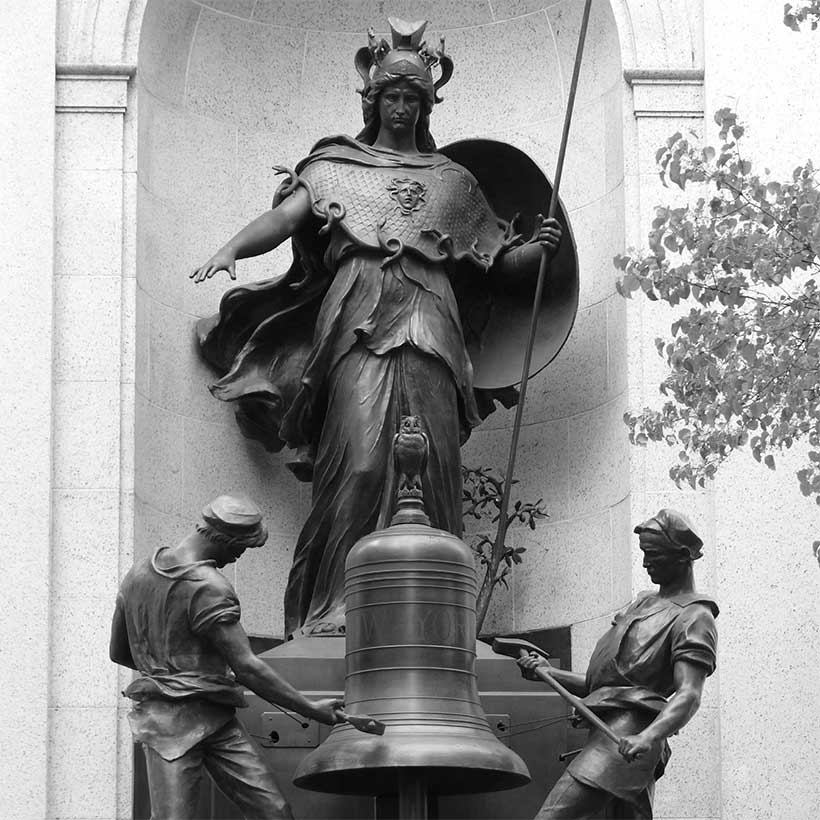Monument of the Month: Ilya Bolotowsky Mural
Celebrating 30 years of public art
Thirty years ago, The Municipal Art Society of New York (MAS) launched the Adopt-A-Monument program in collaboration with the NYC Public Design Commission and the NYC Parks Department, to secure private funding for the rescue of public art in danger of deterioration. To date, MAS’s Adopt programs have raised nearly $4 million dollars to conserve fifty-one works of art in all five boroughs. In honor of the 30th anniversary of the program, we are highlighting one restoration per month in 2017.

There is a rich backstory to the abstract fantasy mural by the renowned painter, Ilya Bolotowsky (1907-1981), recently placed in the Bloomberg Center on the Cornell Tech campus. MAS contributed substantially to the salvation and preservation of this artwork. Like much of the history of New York City, the story is filled with twists and convolutions but always intriguing and interesting.
The Adopt-A-Mural Program was initiated on January 17, 1991, with an event at the MAS Urban Center Gallery. That evening, Works Progress Administration (WPA) scholars gathered to discuss the extraordinary artistic achievements of the WPA and the important need to rescue many of those works from the late 1930s and 1940s that had been neglected or painted over. Ilya Bolotowsky’s 1941 mural, which was created for the circular day room in Goldwater Hospital on Roosevelt Island, was among those endangered works of art.
It would still be another ten years before the Bolotowsky mural was returned to public view in the hospital in July 2001. The restoration would not have been possible without the shared generosity of the Judith Rothschild Foundation, Robert W. Wilson, Mike and Janet Slosberg, and the Hospital.
Bolotowsky created four known murals for New York City while on the WPA. This one is the largest. The mural for the Williamsburg Housing Project (1937) exists but was transferred to the Brooklyn Museum after it was restored in 1989. The mural designed for the Hall of Medical Science, New York World’s Fair (1938-39) was destroyed. The small mosaic created for Theodore Roosevelt High School in the Bronx (1940) remains above a water fountain in the school’s hallway. When a mural survives on the original site, it is a happy moment.
None of us who doggedly and devotedly stayed with this project over the years ever anticipated just how marvelous the Bolotowsky mural would be. It is a masterpiece of American Modernism. For decades the mural lay hidden under seven coats of paint: speckled white, yellow, green, green, pink, and brown.
Luca Bonetti, the Swiss-born, Italian-trained conservator, skillfully carried out the conservation with his staff. They were guided by the knowledgeable Andrew Bolotowsky, Ilya’s son, who had long advocated for his father’s mural to be preserved. The artist Jackson Pollack found a scaled down version of Bolotowsky’s mural with WPA material; Lee Krasner, his wife, saved it and donated it to the Guggenheim Museum. Bolotowsky had the scale maquette version photographed to use for an acrylic reproduction which he was working on before his untimely death in 1981. This was all very lucky because the reproduction enabled Luca to restore the mural exactly as it was created.
The conservator worked with five assistants to chip off the first three layers of paint with chisels, a painstaking process for a 350 square foot mural. For the next four layers, he applied a paint-removing solvent paste with a brush and then peeled off the layers with a special paper. Then they injected an adhesive where the canvas base of the mural was detaching from the wall.
Bolotowsky was founder of the American Abstract Artists in 1936, a group that included Mondrian. They created purely abstract art in a style known as Neo-Plastic. When Bolotowsky wrote his proposal for the WPA commission for the hospital (known as the Hospital for Chronic Diseases in 1939), he said “the most suited design for a hospital mural should contain no definite subject matter but should be generally soothing in its line and color.” The painting began at waist height, for he wanted the seated patients to feel the universe was bigger as they sat in their wheelchairs. With the mural on one side of the semi-circular room and a bay of windows facing the East River on the other, space and art merged into a peaceful equilibrium.
Upon learning in 2011 that Goldwater Hospital would be demolished to build the new Cornell Tech campus, there was deep concern as to the fate of this treasured WPA mural. Fortunately, with the endorsement of the Bloomberg administration, Cornell agreed to include Bolotowsky’s mural as a component in their campus design. In addition, two other previously hidden WPA murals by Albert Swinden and Joseph Rugolo were removed and rescued at the same time.
Fine Art Conservation Group, headed by Suyeon Kim (who had worked with Mr. Bonetti on the original conservation), and Helen Im were hired to detach the Bolotowsky canvas, consolidate the paint layers that would be affected during this process, remove lead white, plaster, and adhesive from the back of the canvas, and then transport the mural roll on round tubes to their studio for conservation.
This September, the mural was reinstalled on walls that attempt to capture the original curve and dimensions of the space for which the artwork was designed. In a world where change is inevitable, it is reassuring that the mural conforms to its original vision to provide serenity – now, hopefully, into the next millennium.



